Chess game rules
Chess is the most popular board game in the world.
Chess came from Indian, derived from Chaturanga, a board game already practised in India between the 5th and 6th centuries. Chess migrated to Persia, where quickly reached a great popularity. Later, between 7th and 9th centuries, Islam conquests introduced it in the southern part of Europe; the crusades and Vikings contributed to extend chess to the rest of Europe.
The current chess rules were consolidated between the 16th and 17th centuries.
You can read the official rules if you want more detailed information about the game.
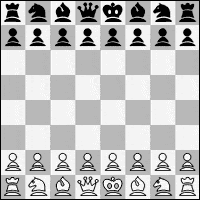
Board and pieces
Two player take part in the game. At the beginning of the game each player has 16 pieces (white and black respectively), placed in their two nearest ranks on the 8x8 board. The 16 pieces are: 8 pawns, 2 rooks, 2 knights, 2 bishops, one king and one queen.
Moving the pieces
Each turn consists in moving one piece to another square, that we call destination. Moves must satisfy these conditions:
- The destination may be an empty cell.
- The destination may be an square occupied by an opponent piece. In this case the piece is captured and removed from the board.
- The destination cannot be an square occupied by an own piece.
- The squares that the piece crosses to the destination must be empty, unless the moved piece is a knight
The ultimate goal of the game is to capture the opponent's king.
The Rook
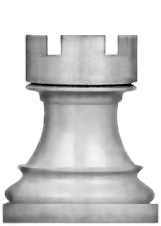
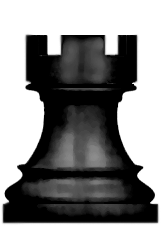
The rooks, initially placed on the corners of the board, may move to any square along the file or the rank on which they stand.
The Knight


Each player has two knights, placed next to the rooks by both sides of the board.
They make L-shaped moves: two squares on a vertical or horizontal rank, and then another square perpendicular.
Unlike the other pieces, they can jump over occupied squares by own pieces or rivals.
The Bishop
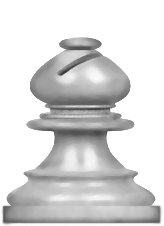

The third piece from each corner is the bishop.
Bishops may move to any square along a diagonal on which they stands.
The Queen


The queen may move to any square along the file, the rank or a diagonal on which it stands; so, it can be moved like a rook and like a bishop.
The King

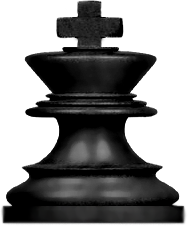
The king may be moved to any adjoining square not attacked by one or more of the opponent’s pieces. Castling move is also possible from its starting position, advancing two squares on the first rank.
The Pawn


Each player has 8 pawns, placed on the second rank, and they are moved peculiarly:
- They only move forward, never back or sideways.
- They can move one step forward to an empty square. Optionally, one pawn can be moved two squares forward in its first move.
- They can capture moving forward to a square which is diagonally adjacent.
- A pawn attacking a square crossed by an opponent’s pawn which has just advanced two squares in one move from its original square may capture this opponent’s pawn as though the latter had been moved only one square. This is called an en passant capture.
- When a pawn reaches the rank furthest from its starting position it must be exchanged inmediately for a new piece (usually a queen, the more valuable). This exchange of a pawn for another piece is called promotion.
Castling
The castling is a special move that can be made once during the game, and entails the movement of two pieces.
The king is transferred from its original square two squares towards left or right, and the rook in the correspondig corner is transferred to the square the king has just crossed.
The castling is an effective play to protect the king, and it is only possible undeer the following conditions:
- Both pieces, the king and the rook, has not been moved during the game.
- The squares between them are empty.
- The king is not in check, and neither the destination square nor the crossed squares cannot be under threat.
Check
The king is said to be in check when it is under threat of capture by one or more opponent's pieces.
When the king is in check, it is compulsory to make a move that prevents its capture. This can be achieve by moving the king to a square not threatened, capturing the threatening piece, or putting another piece inbetween.
Also, the king can not be moved to a threatened square.
Checkmate
The checkmate is achieved when the king is in check and there is not any legal move to prevent the attack.
The player who checkmates the opponent's king wins the game.
Draw
The game is drawn in the following situations:
- Both players agree.
- The same position (the same arrangement of pieces on the board) is repeated for the third time.
- 50 moves pass since the last capture or move of a pawn.
- Stalemate: the king is not currently in check, but all the possible moves would left him in check.
Play modes in Ludoteka
Ludoteka offers four very different modes to play chess online:
 Traditional Chess Mode
Traditional Chess Mode
 Blitz Chess Mode
Blitz Chess Mode
Blitz chess is a variation of chess in which each side is given very short time to make the moves.
It is considered as a distinct form of classical chess because the time constraint forces to think differently.
 Chess960 Mode
Chess960 Mode
Chess960 (or Fischer Random Chess) is a variant in which the initial position of the pieces is randomized between 960 different options.
The 8 pawns are placed in the second rank, as in Traditional Chess, but the position of the other 8 pieces is raffled with these constraints:
- Positions are symmetrical for both players.
- The two bishops must be placed on different colored squares
- There is always one tower on each side of the king.
The rules of the game are exactly the same as in classical chess, but it is necessary to point out the conditions for castling:
- The destination squares for the king and the rook are the same as traditonal chess, regardless of their starting position.
- Castling is possible if the king and the rook has not been moved, there is not any other piece on the crossed squares, and the king does not cross any threatened square.
 Antichess variant
Antichess variant
Antichess is a variant of chess in which the goal is to finish without being able to make any move.
It is also known as suicide chess, losing chess, giveaway chess...
These are the differences with respect to traditional chess:
- The winner is the one who cannot make any move, either because he runs out of pieces, or because remainig pieces are blocked.
-
The king is like the other pieces:
- His capture does not end the game.
- There is no check or checkmate.
- Castling is not allowed.
- When promoting a pawn, it can also become a king.
- It is mandatory to make a capturing move whenever possible. When there are several possible capturing moves, you can freely choose any of them.
- Draws are possible by agreement, by repetition of movements and by the absence of captures during 50 movements. But there is not stalemale because, according to the rules, the player who cannot move wins the game.